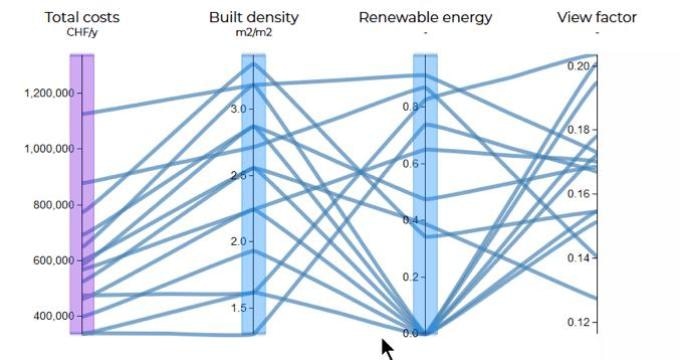Jan 25 2019
Scientists at EPFL have created a web-based software program that adopts a whole new strategy to urban planning.
 Each horizontal line represents a variant, clearly indicating the variant’s score on different criteria such as total cost, built density and use of renewable energy. (Image credit: EPFL)
Each horizontal line represents a variant, clearly indicating the variant’s score on different criteria such as total cost, built density and use of renewable energy. (Image credit: EPFL)
Planners just input the different ideas they need to attain—with reference to the quality of life, built density, use of renewable energy, cost, and so on—and the program produces the best possible variants for their city. This can assist city officials in taking better decisions, particularly in terms of promoting sustainable development.
When designing development programs, urban planners should consider a large number of different objectives. For instance, these can include preserving old monuments and buildings, optimizing the built density of a neighborhood, lowering CO2 emissions, reducing costs, and using renewable energy. These objectives are usually conflicting and difficult to quantify, and cannot be understood fully at times.
However, a new approach to urban planning, known as SAGESSE, and an associated software program to help urban planners have been developed by two scientists, Sébastien Cajot and Nils Schüler, at EPFL’s School of Engineering Industrial Process and Energy Systems Engineering (IPESE) Group headed by Professor François Maréchal.
Their program is available as a web application and allows planners to input the criteria vital to them and receive a quick outline of the different variants possible. Cajot and Schüler collaborated with the Canton of Geneva to create their software, testing it out on the Cherpines and Palettes neighborhoods. The findings of the researchers have been published in Frontiers ICT.
An Inverted Approach
For us, the current approach to urban planning gets things backwards. Planners typically outline four or five possible variants for a given neighborhood and then model them to quantify the impact of each.
Sébastien Cajot, Researcher, School of Engineering Industrial Process and Energy Systems Engineering, EPFL.
Sébastien Cajot has just completed his thesis on this inverted approach.
However, urban planning needs bringing together of the interests of several different stakeholders—such as city residents, property developers, local representatives, and energy planning officials—who often have contradictory ideas.
“For any one goal, there could be millions of possible variants to achieve it,” says Cajot. For example, the objective of reducing CO2 emissions can be achieved by setting up district heating, renovating a city’s building facades, or replacing old boilers. However, the existing technique for evaluating the influence of each option are inadequate—rendering it difficult for urban planners to make well-informed decisions.
First the Values, then the Variants
Urban planners should start not by asking whether they should build a high-rise building, for example, but by establishing the main goals they want to achieve, such as optimizing a city’s density, improving its quality of life or managing development costs. Our software enables them to start from this basis and come up with the best variants.
Sébastien Cajot, Researcher, School of Engineering Industrial Process and Energy Systems Engineering, EPFL.
The program creates straightforward diagrams representing the variants as horizontal lines plotted against vertical axes, where each axis is an urban development objective. For instance, the diagram could show that a variant fulfilling built-density targets and specific cost deviates from renewable-energy-use regulations or hinders the view from other buildings. In this manner, urban planners can modify their objectives and targets and finally find a variant that could be accepted by all.
Pilot Tests in Geneva
Initially, the scientists tested their software on the development of the new Cherpines neighborhood, near Geneva. Next, they tested it out on the existing Geneva neighborhood of Palettes, to view how it could help enhance already developed areas. They worked with local officials to find out the priorities of the urban development. “They wanted to focus on increasing urban density, cutting CO2 emissions and protecting the local heritage,” says Cajot. The scientists also factored legal requirements into their software and designed it in such a way that it is compatible with current zoning documents, such as master plans. Their software weighs these different elements and computes a series of urban planning options using algorithms.
In the near future, the scientists intend to open a startup to market their urban planning software and approach. Moreover, the IPESE Group is examining the application of the technology in other fields, for instance, helping to execute Switzerland’s energy strategy, determining optimal biomass conversion processes, and planning out renewable-energy use.
Urbio: Interactive optimization for planning sustainable cities
(Video credit: EPFL)